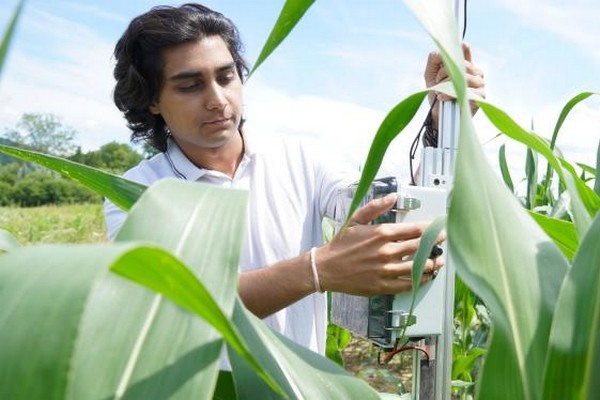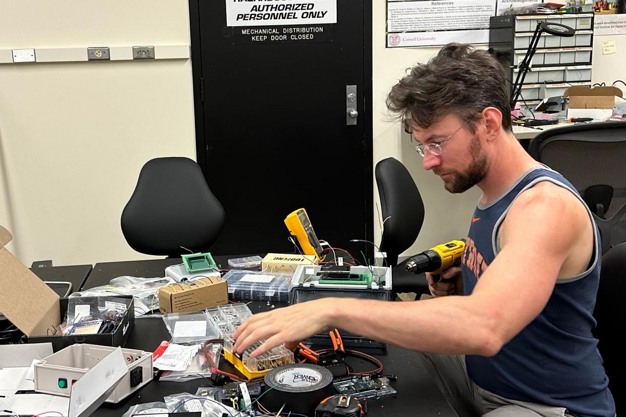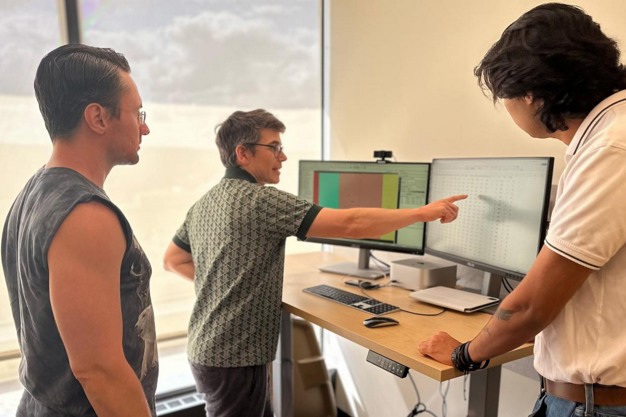At CAST for the Farm of the Future, researchers from different disciplines combined their knowledge to develop CHIMES, a prototype micro-environment sensor system for high-throughput data collection.

Data collection for agricultural field research can be cumbersome and tedious. Researchers commonly use multiple sensors to gather data from plants, soil and air—all at the same time. The result can be an armload of technology that needs to be carried into the field, each with its own data logging system. And at the end of it all waits complicated post-processing assembly of the disparate data.
Enter the Cornell Agricultural Testbed and Demonstration Site (CAST) for the Farm of the Future. The interdisciplinary team of researchers at CAST are creating an ecosystem of networked technologies and techniques to meet the needs of 21st-century farms. That can mean everything from testing and integrating biosensors that monitor the health of individual dairy cows to developing a process for assessing crop fertilizer application via drones and satellites.
"CAST is a framework for the development and testing of data-driven solutions to today's most pressing farm challenges," said Dr. Julio Giordano, professor of animal science and CAST director. "Along with that, CAST also facilitates solving technological issues associated with digital agriculture research."

For Louis Longchamps, assistant professor in the School of Integrative Plant Science, Soil and Crop Sciences Section, and CAST associate director, the problem of how to monitor the microenvironment of crops was an on-going one. He knew the sensors needed to be combined, but how? That's when Longchamps's graduate student Alexander Yore, PhD '27, stepped in.
Yore has an undergraduate degree in electrical engineering and felt up to the challenge of tackling the sensors. He suggested combining three sensor types that are crucial to his PhD research into interseeding—the planting of cover crops between rows of field crops to provide more nitrogen, prevent weed growth, or help build soil health. Siddhant Ahlawat '24, a master's student in electrical engineering, soon joined the sensor project, and the race was on to create a prototype for the 2024 growing season.
The three sensors give different types of data in different formats, Yore explained. Two of the sensors are photosynthetically active radiation (PAR) sensors that sense sunlight in the range of 400 to 700 nanometers, where plants can make use of it. One PAR sensor senses above the canopy and one below it to give the ratio of how much light is striking the plants at the top versus how much reaches ground level. The third sensor measures various parameters of the soil, such as moisture, temperature and bulk electrical conductivity.
"It's very time-consuming to use all these sensors individually because we're trying to do high-throughput data collection, which means we're taking data at a lot of points in the field," Yore said. "And for every point, we have to take a measurement from sensor one and then from sensor two and then from sensor three. Finding a way to make that more efficient is really important."

Yore and Ahlawat combined the sensors into a system they call a Crop Health Integrated Micro-Environment Sensor (CHIMES) that requires one push of a button. A micro-controller gathers data from all the sensors at once. The data is then sent to the cloud and can be downloaded as a spreadsheet.
Researchers should find CHIMES useful, but it also has the potential to help farmers, Yore said. Knowing the amount of sunlight that is reaching the ground between rows of crops, as well as soil parameters, can assist farmers with things like weed control and interseeding decisions.
"Institutions and infrastructure like that available at CAST are where disciplines meet to achieve common goals. Without that infrastructure, this sort of innovation might not happen," said Louis Longchamps.
The researchers intend to keep CHIMES an open-source technology. "We're creating a GitHub site," Ahlawat said. "We'll put everything up there: the links to the parts we used and how to connect them, the circuit diagrams and the code we created. That way, anyone can make one of these systems and start using it."
CAST played an important role in the development of the integrated sensor system, Longchamps explained. "Institutions and infrastructure like that available at CAST are where disciplines meet to achieve common goals," he said. "Without that infrastructure, this sort of innovation might not happen. Electrical engineers and agroecologists may not have the opportunity to think of such a simple and integrated system as CHIMES. The engineers wouldn't be aware of the need and the agroecologists may not know how to make it happen."
Source: cals.cornell.edu

